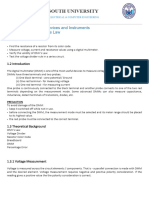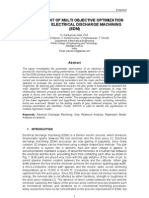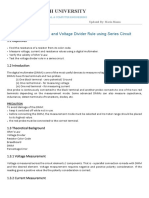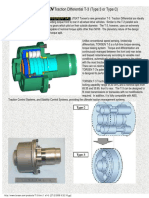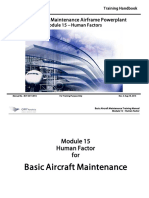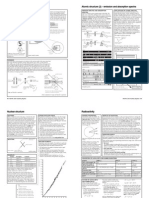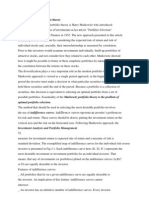EEG383 Measurement - Problem Set 2 - Measurement - Errors
EEG383 Measurement - Problem Set 2 - Measurement - Errors
Uploaded by
dromakiCopyright:
Available Formats
EEG383 Measurement - Problem Set 2 - Measurement - Errors
EEG383 Measurement - Problem Set 2 - Measurement - Errors
Uploaded by
dromakiOriginal Description:
Original Title
Copyright
Available Formats
Share this document
Did you find this document useful?
Is this content inappropriate?
Copyright:
Available Formats
EEG383 Measurement - Problem Set 2 - Measurement - Errors
EEG383 Measurement - Problem Set 2 - Measurement - Errors
Uploaded by
dromakiCopyright:
Available Formats
Misr International University Faculty of Engineering Term: Fall 2010 Department of Electronics and Communication
Course: EEG 383 Electrical Measurements and Instrumentations Instructor: Prof. Fawzy Ibrahim TA: Eng. Waleed Elhalwagy
Problem Set #2 Measurement Errors Question 2.1 Explain the difference between systematic and random errors. What are the typical sources of these two types of errors? Question 2.2 In what ways can the act of measurement cause a disturbance in the system being measured? Question 2.3 What procedures are normally taken to avoid measurement errors when using instruments that are subjected to changing ambient conditions? Question 2.4 For the circuit given in fig.(1), if the instrument measuring the output voltage across 270 ohm resistance has resistance of 5000 ohm. What is the measurement error due to the loading effect of the instrument? Question 2.5 For the circuit given in fig.(2), if the instrument measuring the output voltage across 500 ohm resistance has resistance of 4750 ohm. What is the measurement error due to the loading effect of the instrument?
Fig.(1)
Fig. (2)
Question 2.6 For the circuit given in fig.(3), the current flowing in the 500 ohm is to be measured using a 100 ohm ammeter. What is the loading effect of the measurement instrument?
Fig. (3)
MIU EEG 383 Problem Set # 2 Measurement Errors Page 1 of 2
Question 2.7 In a survey of 15 owners of a certain model of a car, the following figures for average petrol consumption were reported : 25.5 30.3 31.1 29.6 32.4 39.4 28.9 30 33.3 31.4 29.5 30.05 31.7 33 - 29.2 Calculate the mean value, the median and the standard deviation of the data set. Question 2.8 The following measurements were taken with analog meter, due to random errors: 21.5 mA 22.1 mA 21.3 mA 21.7 mA 22 mA 22.2 mA 21.8 mA 21.4 mA 21.9 mA 22.1 mA Calculate the mean value, the median and the standard deviation of the data set. Question 2.9 A 3 volt dc power source is obtained using two 1.5 V series batteries. If the error in each is 1%. Calculate the maximum possible error in the 3 V power source. Question 2.10 In order to calculate the heat loss through wall of building, the temperature difference was measured at both sides of the wall was 5 C and 20 C , by thermosters with a range 0 C to 50 C and th reading inaccuracy is 1% of full scale reading, calculate the maximum possible error in the calculated figure for the temperature difference. Question 2.11 The power dissipated in a load is measured as P = V.I, errors in measured voltage and current are 1% and 2% respectively. Calculate the maximum likely error in the power value. Question 2.12 In measuring R = V/I , the measured voltage was 10 0.1 V, current = 214 5 mA. Express the value of the resistance. Question 2.13 In measuring the density, d = m/ (a+b+c), error in a,b,c,m were 1% , 1% , 2% and 0.5% , determine the maximum possible error in the measured density.
MIU
EEG 383 Problem Set # 2 Measurement Errors
Page 2 of 2
You might also like
- Torsen Application ChartDocument1 pageTorsen Application ChartdromakiNo ratings yet
- Laboratory Exercise 2 DC Sources and MeteringDocument4 pagesLaboratory Exercise 2 DC Sources and MeteringBolocon, Harvey Jon DelfinNo ratings yet
- Torsen T-1 Technical SheetDocument2 pagesTorsen T-1 Technical SheetdromakiNo ratings yet
- Motoman MRC TroubleshootingDocument153 pagesMotoman MRC Troubleshootingnestor gonzalez de leon100% (1)
- 25 Bui Hoai NamDocument2 pages25 Bui Hoai NamThương Trịnh HoàngNo ratings yet
- AC Mitigation Sample ReportDocument14 pagesAC Mitigation Sample ReportebalideNo ratings yet
- Lab 3 Report FinalDocument13 pagesLab 3 Report FinalrajNo ratings yet
- 13 Ngo Tri HieuDocument2 pages13 Ngo Tri HieuViet Anh Dao DucNo ratings yet
- Energies: Testing of Electrical Energy Meters Subject To Realistic Distorted Voltages and CurrentsDocument13 pagesEnergies: Testing of Electrical Energy Meters Subject To Realistic Distorted Voltages and CurrentsWalter EguizabalNo ratings yet
- Circuits Lab Exp 5 ReportDocument17 pagesCircuits Lab Exp 5 Reportਰਣਜੀਤ ਢਿੱਲੋਂNo ratings yet
- Lab 2Document8 pagesLab 2hunain akhtarNo ratings yet
- Ee521 Test 1 2020 - DeferredDocument1 pageEe521 Test 1 2020 - DeferredKhondwani BandaNo ratings yet
- Circuits Lab Exp 2 ReportDocument15 pagesCircuits Lab Exp 2 ReportEdamEdamNo ratings yet
- Experiment #2 Final - Report - CODocument7 pagesExperiment #2 Final - Report - COEisen JaylordNo ratings yet
- Engineering Practice Lab ElectricalDocument23 pagesEngineering Practice Lab ElectricalKrishna Moorthy50% (2)
- Title: To Study and Implement Voltage Divider Circuit Experiment # 07Document3 pagesTitle: To Study and Implement Voltage Divider Circuit Experiment # 07Muhammad Toseef ChohanNo ratings yet
- Addis Ababa Science and Technology University Collage of Electrical and Mechanical Engineering Department of Electrical and Computer EngineeringDocument6 pagesAddis Ababa Science and Technology University Collage of Electrical and Mechanical Engineering Department of Electrical and Computer EngineeringABENEZER EPHREMNo ratings yet
- Assignment ECEG-4261 Microelectronic Devices and Circuits (MDC)Document7 pagesAssignment ECEG-4261 Microelectronic Devices and Circuits (MDC)erenaNo ratings yet
- Resistor Color Code: ObjectiveDocument9 pagesResistor Color Code: ObjectiveEdgar RodríguezNo ratings yet
- Experiment#4 (Superposition)Document3 pagesExperiment#4 (Superposition)Berger GlodiNo ratings yet
- EEE (May 2023)Document298 pagesEEE (May 2023)Durjoy SahaNo ratings yet
- Lab 1Document8 pagesLab 1Farhana RahmanNo ratings yet
- 3rd Experiment h.w3Document5 pages3rd Experiment h.w3علي سالم الكوتNo ratings yet
- Lab 1Document8 pagesLab 1Tawsif ahmedNo ratings yet
- Underground Water Prospecting in Rural Settings: E. C. Mabunda, Beng, MSCDocument10 pagesUnderground Water Prospecting in Rural Settings: E. C. Mabunda, Beng, MSCInternational Journal of computational Engineering research (IJCER)No ratings yet
- 1.distribution Customer Power Quality ExperienceDocument8 pages1.distribution Customer Power Quality ExperienceswatisamadhiyaNo ratings yet
- SWSWSWSSWDocument5 pagesSWSWSWSSWIman AkbariNo ratings yet
- Tutorial Compilation - Update 16 Oct 2015Document9 pagesTutorial Compilation - Update 16 Oct 2015Sarah HarunNo ratings yet
- Assignment No. 3 Due Date: Mar. 3 : EE-341 Microelectronic DesignDocument3 pagesAssignment No. 3 Due Date: Mar. 3 : EE-341 Microelectronic DesignUsama AfzalNo ratings yet
- Lab3Document13 pagesLab3Raed DayyehNo ratings yet
- BEE Record BookDocument57 pagesBEE Record BookIT039- Jeel KalariyaNo ratings yet
- Development of Multi Objective Optimization Model For Electrical Discharge Machining (EDM)Document9 pagesDevelopment of Multi Objective Optimization Model For Electrical Discharge Machining (EDM)Vicky VigneshNo ratings yet
- Practice Questions-1Document3 pagesPractice Questions-1ezekiel makandwaNo ratings yet
- 2004 Doble Paper 3.16.04Document11 pages2004 Doble Paper 3.16.04KUNALJAY100% (1)
- PrintedDocument7 pagesPrintedFari PratomosiwiNo ratings yet
- EE131.1 LabDocument40 pagesEE131.1 LabMarc MontillaNo ratings yet
- Muntimeter and AmmeterDocument4 pagesMuntimeter and AmmeterMohin UddinNo ratings yet
- Sample Question Paper Electrical and Electronic MeasurementDocument4 pagesSample Question Paper Electrical and Electronic MeasurementDeeo Dhadiwal0% (1)
- Power Quality Enhancement Using Custom Power DevicesDocument7 pagesPower Quality Enhancement Using Custom Power DevicesSundhar SivaNo ratings yet
- Skin Effect and Dielectric Loss Models of Power Cables 04784562Document8 pagesSkin Effect and Dielectric Loss Models of Power Cables 04784562Gilberto Mejía100% (1)
- EEE3100S 2022 Tutorial 10 Memo - Power System Protection - KOADocument8 pagesEEE3100S 2022 Tutorial 10 Memo - Power System Protection - KOAStalin KosterNo ratings yet
- North South University: Lab 1: Ohm's Law, KVL, and Voltage Divider Rule Using Series CircuitDocument12 pagesNorth South University: Lab 1: Ohm's Law, KVL, and Voltage Divider Rule Using Series CircuitNazmul Hasan 1911742042No ratings yet
- Electrical Circuit Lab ReportDocument9 pagesElectrical Circuit Lab Reportapi-239929566No ratings yet
- Session 4 Activity Sheet 2 (Ohms Law)Document2 pagesSession 4 Activity Sheet 2 (Ohms Law)ISAGANINo ratings yet
- Experiment #2 Final - Report - CO PDFDocument6 pagesExperiment #2 Final - Report - CO PDFEisen Jaylord100% (1)
- Measurement of Three-Phase Transformer Derating and Reactive Power Demand Under Nonlinear Loading ConditionsDocument8 pagesMeasurement of Three-Phase Transformer Derating and Reactive Power Demand Under Nonlinear Loading ConditionsSaurav KafleNo ratings yet
- Tutorial 1Document3 pagesTutorial 1dfsdsdfsdfsdfsdfsdNo ratings yet
- Lab Report 2Document19 pagesLab Report 2Sarah HarunNo ratings yet
- MEMS & Microsystems Design & Manufacturing SolutionDocument50 pagesMEMS & Microsystems Design & Manufacturing SolutionDeepak Gowda100% (1)
- Circuits Lab Exp 4 ReportDocument15 pagesCircuits Lab Exp 4 ReportEdamEdamNo ratings yet
- Modelling Voltage Sag Mitigation Using Dynamic Voltage Restorer and Analyzing Power Quality IssueDocument9 pagesModelling Voltage Sag Mitigation Using Dynamic Voltage Restorer and Analyzing Power Quality Issue1978ECRNo ratings yet
- Blow Up - SensorsDocument9 pagesBlow Up - SensorsbobblytasticNo ratings yet
- Electrical Impedance Tomography ThesisDocument5 pagesElectrical Impedance Tomography Thesisshaunajoysaltlakecity100% (2)
- EMI Previous Question Papers Topic Wise PDFDocument24 pagesEMI Previous Question Papers Topic Wise PDFjaganmohanrsNo ratings yet
- Eee 141 Lab 1Document11 pagesEee 141 Lab 1KameelNo ratings yet
- Electronics Lab 2 Kabdylkak Arnur ST-2305Document7 pagesElectronics Lab 2 Kabdylkak Arnur ST-2305kabdylkakarnurNo ratings yet
- EE204 LabDocument37 pagesEE204 LabKrishnaveni Subramani SNo ratings yet
- Acquintance of Electrical Lab and Its Equipments - B1Document15 pagesAcquintance of Electrical Lab and Its Equipments - B1AshleyNo ratings yet
- Assignment Power ElectronicDocument13 pagesAssignment Power ElectronicAfiq ZahinNo ratings yet
- Design and Implementation of Portable Impedance AnalyzersFrom EverandDesign and Implementation of Portable Impedance AnalyzersNo ratings yet
- Introduction to Power System ProtectionFrom EverandIntroduction to Power System ProtectionRating: 5 out of 5 stars5/5 (1)
- T 1Document2 pagesT 1dromakiNo ratings yet
- Traction Control ArticleDocument8 pagesTraction Control ArticledromakiNo ratings yet
- Torsen T-3 DifferentialDocument4 pagesTorsen T-3 DifferentialdromakiNo ratings yet
- T-2R (RaceMaster) PDFDocument3 pagesT-2R (RaceMaster) PDFdromakiNo ratings yet
- T-2R (RaceMaster) PDFDocument3 pagesT-2R (RaceMaster) PDFdromakiNo ratings yet
- Torsen General Frequently Asked Questions PageDocument4 pagesTorsen General Frequently Asked Questions PagedromakiNo ratings yet
- Gleason's Impossible DifferentialDocument2 pagesGleason's Impossible Differentialdromaki100% (2)
- Headgasket Case History PDFDocument3 pagesHeadgasket Case History PDFdromakiNo ratings yet
- OPTIMA (MG) 2010 G 2.7 DOHC Smart Key SystemDocument6 pagesOPTIMA (MG) 2010 G 2.7 DOHC Smart Key SystemdromakiNo ratings yet
- Detonation (Detonation Information)Document4 pagesDetonation (Detonation Information)dromakiNo ratings yet
- Garrett ManualDocument1 pageGarrett ManualdromakiNo ratings yet
- Bolt Tightening e PDFDocument15 pagesBolt Tightening e PDFdromaki0% (1)
- Question Bank - IWT - 2019Document5 pagesQuestion Bank - IWT - 2019Saptadip Saha0% (1)
- So, You Want To Build An Astromech? Beginner's GuideDocument20 pagesSo, You Want To Build An Astromech? Beginner's GuideDino IgnacioNo ratings yet
- Week2 DLL EnglishDocument8 pagesWeek2 DLL EnglishMa Michelle FranciscoNo ratings yet
- Pps Fold (1) - 1Document23 pagesPps Fold (1) - 1srilikki16No ratings yet
- M15. Human Factors-1Document305 pagesM15. Human Factors-1Bela Firmantoyo100% (1)
- Swimming Gears and Basic Water Safety P.E 4 G12Document10 pagesSwimming Gears and Basic Water Safety P.E 4 G12fayebaguingey5No ratings yet
- Modicon M262 - TM262L10MESE8TDocument13 pagesModicon M262 - TM262L10MESE8Tfeinrae3No ratings yet
- 15 ST Split KorčulaDocument13 pages15 ST Split KorčulabaredineNo ratings yet
- Building Materials and Construction - IIIDocument11 pagesBuilding Materials and Construction - IIIAleena AsifNo ratings yet
- Acer TFT-LCD Color Monitor X203H Service GuideDocument47 pagesAcer TFT-LCD Color Monitor X203H Service Guidebinsakluis1808No ratings yet
- The Sleight of Hand Script Final DraftDocument2 pagesThe Sleight of Hand Script Final Draftapi-639900060No ratings yet
- Practice Test 1: Questions 1-6Document10 pagesPractice Test 1: Questions 1-6hoang trinh100% (1)
- Excavation and TrenchingDocument12 pagesExcavation and TrenchingWahyu Endra PurwantoNo ratings yet
- Proposals and Formal Reports: Mary Ellen Guffey, Essentials of Business Communication, 6eDocument21 pagesProposals and Formal Reports: Mary Ellen Guffey, Essentials of Business Communication, 6eNoor shahNo ratings yet
- BGCSE ENGLISH LANGUAGE PAPER 1 REVISION - Introductory ParagraphsDocument8 pagesBGCSE ENGLISH LANGUAGE PAPER 1 REVISION - Introductory ParagraphsNothando PhologotswanaNo ratings yet
- RR-US590 RR-US570: Operating Instructions IC RecorderDocument44 pagesRR-US590 RR-US570: Operating Instructions IC RecorderjaureguinievesNo ratings yet
- 151266how To Save Money On wgw88Document2 pages151266how To Save Money On wgw88eferdolkxiNo ratings yet
- 97 Information and Questions SheetDocument4 pages97 Information and Questions SheetMilintorn WongchinchaiNo ratings yet
- Earthing SystemDocument4 pagesEarthing SystemMerin MariamNo ratings yet
- BSTS101P Quantitative-Skills-Practice-I Lo 1.0 65 BSTS101PDocument3 pagesBSTS101P Quantitative-Skills-Practice-I Lo 1.0 65 BSTS101PMinaNo ratings yet
- 123 AwatgDocument27 pages123 AwatgPrasadi IidiotNo ratings yet
- 1659374919-Chem 7Document2 pages1659374919-Chem 7شعمروم المكمعرNo ratings yet
- Dellonda Portable Wood-Fired 14 Pizza Oven and Smoking Oven Bl-Job 49Document11 pagesDellonda Portable Wood-Fired 14 Pizza Oven and Smoking Oven Bl-Job 49Chris FarrugiaNo ratings yet
- C18 Generator Set - Maintenance IntervalsDocument59 pagesC18 Generator Set - Maintenance IntervalsRasoolKhadibiNo ratings yet
- IGNOU Mca Network Solved AssignmentDocument15 pagesIGNOU Mca Network Solved AssignmentKamal TiwariNo ratings yet
- TG-4506 - Flag 6 CablesDocument38 pagesTG-4506 - Flag 6 CablesJason SecretNo ratings yet
- Weed Control: JimsonweedDocument5 pagesWeed Control: JimsonweedJonathan FestinNo ratings yet
- Centripetal Force LabDocument5 pagesCentripetal Force Labmt9260100% (4)
- NCMB 316 Assignment NCP Part 2Document3 pagesNCMB 316 Assignment NCP Part 2I'm a PepegaNo ratings yet





















